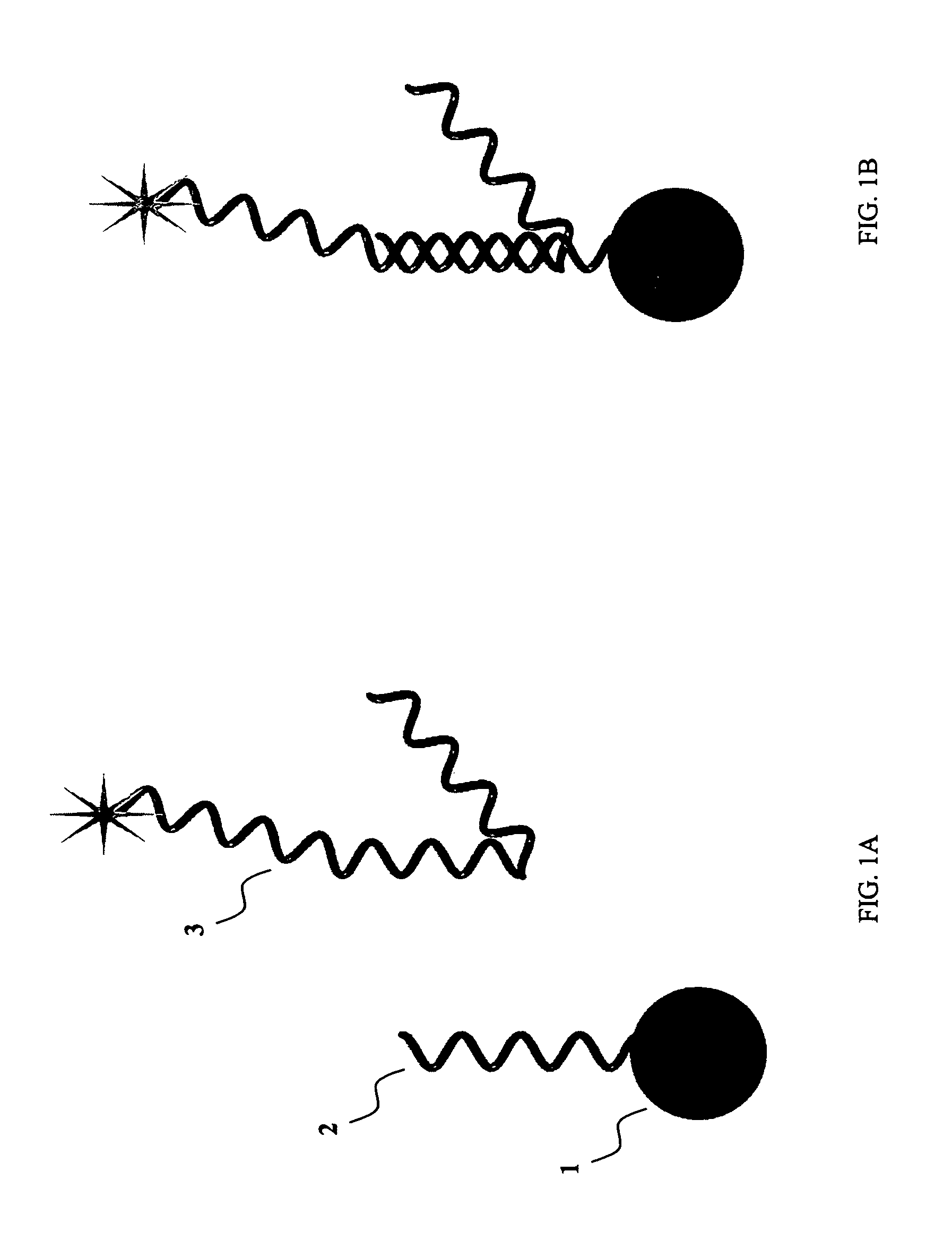System and method for inhibiting the decryption of a nucleic acid probe sequence used for the detection of a specific nucleic acid
a nucleic acid and probe sequence technology, applied in the field of molecular biology, can solve the problems of troops' dress, costing money, and difficulty in maintaining intellectual property protection for the use of specific sequences for diagnostic purposes, and achieve the effect of reducing or preventing the ability of a person to design
- Summary
- Abstract
- Description
- Claims
- Application Information
AI Technical Summary
Benefits of technology
Problems solved by technology
Method used
Image
Examples
example 1
Sequence-Specific Oligonucleotide Hybridization in the Presence of Masking Sequences Using the Luminex xMAP Multiplexing System
The inventors used the Luminex xMAP multiplexing system to demonstrate the feasibility of using masking sequences in sequence-specific oligonucleotide hybridization assays. The xMAP system utilizes fluorescently coded microspheres as an assay reaction surface to capture and detect the presence of various biomolecules. A potential caveat of using masking oligonucleotides in the xMAP system is the potential to reduce sensitivity due to a reduction in the total number of specific probes coupled to each microsphere. However, the inventors demonstrated that the sensitivity of the system to binding sample DNA is either not reduced or only slightly reduced in the presence of one, two, or three masking nucleic acid molecules co-conjugated with a specific detection nucleic acid molecule to the surface of the microsphere.
Coupling Oligonucleotides to the Luminex Micros...
example 2
Detection of PCR™ Amplicons From Human Patient Samples by Sequence-Specific Oligonucleotide Hybridization in the Presence of Masking Sequences Using the Luminex xMAP Multiplexing System
To further demonstrate the feasibility of using masking sequences in sequence-specific oligonucleotide hybridization assays the inventors used the Luminex xMAP multiplexing system to detect alleles amplified from three different patient samples.
Patient Samples. Purified Reference DNA samples were ordered from UCLA Immunogenetics Center. The samples were of previously identified DQ-alpha HLA types. Two samples were known to be representative of the Detection Sequence. An additional sample was known to be negative for the Detection Sequence.
PCR Amplification. Primer Sequence Sets were purchased commercially. The forward Primer Sequence is 5′-ATG GTG TAA ATC TGT ACC AGT-3′ (SEQ ID NO: 13), and the reverse Primer Sequence is 5′-TTG GTA GCA GCG GTA GAG TTG-3′ (SEQ ID NO: 14). Both of the above mentioned pr...
example 3
PCR Amplification of Human Patient Samples with Primer Sequence Sets Alone or in the Presence of Masking Sequence Primer Sets
To further demonstrate the feasibility of masking sequences, the inventors amplified human patient samples using PCR™ amplification with specific primer sets alone or in the presence of one, two, or three masking sequence primer sets. The amplified samples were then detected using detection nucleic acid molecule-coupled xMAP microspheres. The same human patient DNA samples were used for this example as were used in Example 2.
PCR Amplification. Masking Sequence Primer Sets were ordered commercially. The forward and reverse specific primers were identical to those listed in Example 2 (forward specific primer, 5′-ATG GTG TAA ATC TGT ACC AGT-3′ (SEQ ID NO:13); reverse specific primer, 5′-TTG GTA GCA GCG GTA GAG TTG-3′ (SEQ ID NO:14)). The forward Masking Sequence Primer 1 is 5′-TCT CCT AGG TAC ATC TAA TCC-3′ (SEQ ID NO: 15), and the reverse Masking Sequence Primer...
PUM
| Property | Measurement | Unit |
|---|---|---|
| temperature | aaaaa | aaaaa |
| ionic strength | aaaaa | aaaaa |
| temperature | aaaaa | aaaaa |
Abstract
Description
Claims
Application Information
 Login to View More
Login to View More - R&D
- Intellectual Property
- Life Sciences
- Materials
- Tech Scout
- Unparalleled Data Quality
- Higher Quality Content
- 60% Fewer Hallucinations
Browse by: Latest US Patents, China's latest patents, Technical Efficacy Thesaurus, Application Domain, Technology Topic, Popular Technical Reports.
© 2025 PatSnap. All rights reserved.Legal|Privacy policy|Modern Slavery Act Transparency Statement|Sitemap|About US| Contact US: help@patsnap.com



